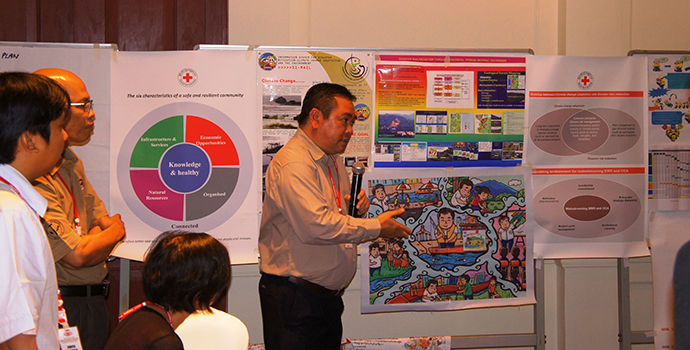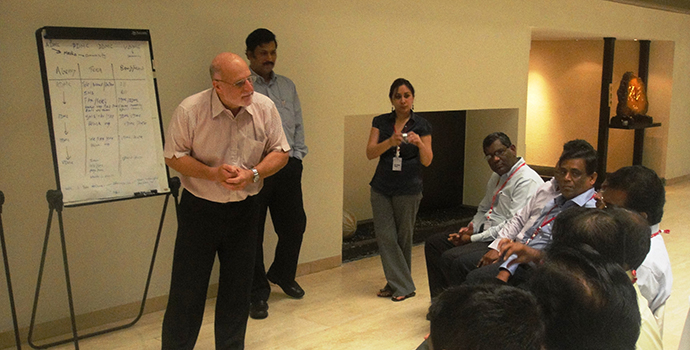- About Us
-
Who we are
-
- Publications
-
- ADPC Academy
-
MediaADPC'S NEWS
Saving lives through improved disaster leadership Saving lives through improved disaster leadership
1 Nov 2014
Bangkok, Thailand
One of the reasons for the slow improvements to disaster risk management (DRM) is the lack of effective leadership. Fortunately, government officials, policy planners and implementers as well as ground-level practitioners are increasingly involved in combating the effects of these hazardous events.
“Resilience is always mentioned in the context of disaster. However, often overlooked is the critical role leadership plays in developing resilience. The roles played by media, academia, NGOs and the private sector can’t be likewise undermined,” states Mr. Avelino Filio, Training Development Officer at ADPC.
ADPC developed the regional Disaster Resilience Lead ership Training Course in partnership with Tulane University’s Disaster Resilience Leadership Academy to strengthen the leadership capacity of disaster risk reduction practitioners. The training course was implemented as part of the Strengthening Leadership in Disaster Resilience Program funded by Bill & Melinda Gates Foundation.
At ADPC’s training on disaster leadership, participants develop disaster risk management action plans that are flexible to challenges related to psychosocial factors, communications, decision making, organizational changes and climate change.
“Disaster leadership challenges include the need to build consensus among stakeholders with different interests and priorities and the ability to maintain the stakeholder commitment to programs when concrete results may not appear for several years,” observes Mr. Merrick Chatfield, Director of Project One Earth and facilitator of ADPC’s training workshop.
Throughout the two workshops within the course, participants must develop disaster risk management action plans that are flexible to challenges like psychosocial factors, communication, decision making, organizational changes and climate change. These are challenges that practitioners face every day in their work, but may not have been addressed directly.
“Workshop graduates are more knowledgeable on disaster management processes, more confident in their leadership
abilities and more willing to work towards community disaster resilience goals,” Mr. Chatfield says.Through capacity and confidence, leadership emerges naturally
“There are three areas where leaders really need to develop their capacity,” believes Mr. Avelino Filio, “championing the integration of disaster risk reduction and climate change adaptation into development plans, psychosocial and behavioral leadership sciences, and the application of analytical decision making skills and tools.”
“We have learned that leadership will naturally emerge if the knowledge, capacity and confidence are infused into vulnerable communities, enabling them to make decisions securing their own safety,” adds Mr. Sisira Kumara, Head of Training Services Department at ADPC.
As a result of ADPC’s training, participants from different countries are now working to integrate the development of disaster resilience leadership into their respective government’s initiatives and train national disaster management officials. With help from the training participants, two universities in Thailand have already incorporated disaster risk management into their postgraduate curriculum.
In the future, ADPC plans to utilize social media in institutionalizing the knowledge the participants have gained through the training and launch a newsletter on disaster resilience leadership to promote knowledge-sharing, networks and partnerships.
As a result of ADPC’s training, participants from different countries are now working to integrate the development of disaster
resilience leadership into their respective government’s initiatives and to train national disaster management officials.
A new master’s program on disaster management in Sri Lanka Professor Dr. B. S. B. Karunaratine, Head of the Department of Science at Peradeniya University in Sri Lanka, participated in the first Disaster Resilience Leadership Training in 2012 and returns each year as an alumni to aid the new participants.
The training assisted him in developing a master’s program in disaster management at his university. “Through the training, I became more flexible in organizing my own program, which is why it was so successful. We managed to train over fifty Sri Lankans from different sectors: high-level administrative officers to academic learners and various other people within the marine, air and military forces and the medical sector.”
He emphasizes the importance of the training program to Sri Lanka, which is prone to a variety of different disasters that disrupt people’s lives each year. “Sri Lanka faces many seasonal floods and we also have tsunamis, earthquakes and cyclones. These are not disasters you can control, but you can control the property placement and increase farmers’ awareness,” Dr. Karunaratine says.
With the help of ADPC’s training and networks, Dr. Karunaratine has successfully acquired external funds for improving the Sri Lankans’ knowledge of disasters through education.By: Asian Disaster Preparedness Center
Download the Impact Story (pdf).Latest NewsRelated Trainings
-